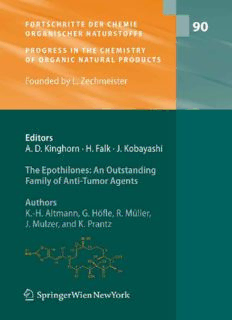Table Of ContentW
Fortschritte der Chemie
organischer Naturstoffe
Progress in the Chemistry
of Organic Natural Products
Founded by L. Zechmeister
Editors:
A. D. Kinghorn, Columbus, OH
H. Falk, Linz
J. Kobayashi, Sapporo
Honorary Editor:
W. Herz, Tallahassee, FL
Editorial Board:
V. Dirsch, Vienna
S. Gibbons, London
N. H. Oberlies, Research Triangle Park, NC
Y. Ye, Shanghai
90
Fortschritte der Chemie
organischer Naturstoffe
Progress in the Chemistry
of Organic Natural Products
The Epothilones: An Outstanding
Family of Anti-Tumor Agents
From Soil to the Clinic
Authors:
K.-H. Altmann, G. Höfle, R. Müller,
J. Mulzer, and K. Prantz
SpringerWienNewYork
Prof.A.DouglasKinghorn,CollegeofPharmacy,
OhioStateUniversity,Columbus,OH,USA
em.Univ.-Prof.Dr.H.Falk,Institutfu¨rOrganischeChemie,
Johannes-Kepler-Universita¨t,Linz,Austria
Prof.Dr.J.Kobayashi,GraduateSchoolofPharmaceuticalSciences,
HokkaidoUniversity,Sapporo,Japan
Thisworkissubjecttocopyright.
Allrightsarereserved,whetherthewholeorpartofthematerialisconcerned,specifically
those of translation, reprinting, re-use of illustrations, broadcasting, reproduction by
photocopyingmachinesorsimilarmeans,andstorageindatabanks.
#2009Springer-Verlag=Wien
PrintedinGermany
SpringerWienNewYorkispartof
SpringerScienceþBusinessMedia
springer.at
ProductLiability:Thepublishercangivenoguaranteefortheinformationcontainedinthis
book.Thisalsoreferstothatondrugdosageandapplicationthereof.Ineachindividualcase
therespectiveusermustchecktheaccuracy oftheinformationgivenbyconsultingother
pharmaceuticalliterature.Theuseofregisterednames,trademarks,etc.inthispublication
does not imply, even in the absence of a specific statement, that such names are exempt
fromtherelevantprotectivelawsandregulationsandthereforefreeforgeneraluse.
LibraryofCongressCatalogCardNumberAC39-1015
Typesetting:ThomsonDigital,Chennai
Printingandbinding:StraussGmbH,69509Mo¨rlenbach,Germany
Printedonacid-freeandchlorine-freebleachedpaper
SPIN:12174249
With52partlycolouredFigures
ISSN0071-7886
ISBN 978-3-211-78206-4 SpringerWienNewYork
The Epothilones: An Outstanding
Family of Anti-Tumor Agents
From Soil to the Clinic
Contents
ListofContributors........................................... IX
1.Preface
J.Mulzer................................................ 1
2.GeneralAspects
G.Ho¨fle................................................. 5
2.1. HistoryofEpothiloneDiscoveryandDevelopment ................. 5
2.1.1. TheEarlyDays ..................................... 5
2.1.2. IndustryBecomesInterestedinEpothilones–andLoses
InterestAgain ...................................... 7
2.1.3. Re-DiscoveryofEpothiloneintheNineties.................. 8
2.1.4. DevelopmentofEpothilonesasAnticancerDrugs ............. 10
2.1.5. Epilogue .......................................... 13
Acknowledgements........................................... 13
References................................................. 14
2.2. NaturalEpothilones ....................................... 16
2.2.1. IsolationandLargeScaleProduction ...................... 16
2.2.2. StructureofEpothilonesandRelatedCompounds.............. 20
2.2.3. PhysicalandChemicalProperties......................... 23
Acknowledgements........................................... 27
References................................................. 27
3.BiosynthesisandHeterologousProductionofEpothilones
R.Mu¨ller................................................ 29
3.1. Introduction............................................. 29
3.2. FeedingStudiesandtheDiscoveryofNaturalEpothiloneVariants....... 32
VI Contents
3.3. IdentificationoftheEpothiloneBiosynthesisGeneCluster............ 36
3.4. StudiesinvitrointotheBiochemistryofEpothiloneAssembly......... 39
3.5. HeterologousExpressionandGeneticEngineering
oftheEpothiloneBiosynthesisGeneCluster...................... 43
3.6. NutrientRegulationinS.cellulosumandM.xanthus................ 47
3.7. Conclusions............................................. 49
Acknowledgements........................................... 50
References................................................. 50
4.TotalSynthesisofEpothilonesA–F
J.Mulzer,K.Prantz ........................................ 55
4.1. Introduction............................................. 56
4.2. SynthesisApproachestoboththeEpothiloneA/C-andB/D-Series ...... 58
4.2.1. DanishefskySyntheses................................. 58
4.2.2. NicolaouSyntheses................................... 67
4.2.3. SchinzerSynthesis ................................... 73
4.2.4. SinhaSyntheses..................................... 77
4.2.5. Carreira’sSynthesisof2aand2b ........................ 81
4.2.6. ShibasakiApproach .................................. 84
4.3. SynthesesofEpothiloneA/C(1a,2a)........................... 87
4.3.1. Fu¨rstner’sAlkyneRCM ............................... 87
4.3.2. LiuSynthesis....................................... 87
4.3.3. PanekApproach..................................... 93
4.3.4. Wong’sDERAApproach............................... 93
4.3.5. Ley’sApproach ..................................... 96
4.4. SynthesisofEpothilonesB/D(1b,2b).......................... 97
4.4.1. MulzerSyntheses.................................... 97
4.4.2. Grieco’sFormalSynthesisof2b ......................... 101
4.4.3. White’sSyntheses.................................... 101
4.4.4. ErmolenkoVariationoftheWhiteSynthesis.................. 105
4.4.5. SynthesisbyE.J.Thomas.............................. 107
4.4.6. Avery’sSynthesis .................................... 109
4.4.7. R.E.Taylor’sSynthesis................................ 111
4.5. SynthesesofFragments .................................... 112
4.5.1. Kalesse’sSynthesisofNicolaou’sIntermediates60and82 ....... 112
4.5.2. Chandrasekhar’sSynthesisofKetoAcid378andC7–C16
Fragment381....................................... 113
4.5.3. Ramachandran’sSynthesisoftheMEM-protected
Nicolaou-Aldehyde(390)............................... 115
4.5.4. DeBrabander’sSynthesisofAldehyde63andAcid59 ......... 115
4.5.5. Wessjohann’sSynthesisofFragments398and401............. 115
4.5.6. Kulinkovich’sSynthesisofAldehyde408 ................... 117
4.5.7. Georg’sSynthesisofAldehyde70 ........................ 117
4.5.8. Lipase-CatalyzedSynthesisoftheC1–C6Fragment414......... 118
4.6. SemisyntheticDegradation/Reconstructionof2b................... 118
Contents VII
4.7. SynthesesofEpothilonesEandF(1c,1d)andTheir
12,13-DeoxyDerivatives(2c,2d).............................. 119
4.7.1. Nicolaou’sSynthesisof1d ............................. 119
4.7.2. Sinha’sSynthesisof1c,1dand2c,2d..................... 119
4.8. Nicolaou’sSynthesisofEpothiloneAnalogues .................... 119
4.9. ConclusionandIndustrialApplication(ZK-Epo(Sagopilone)).......... 123
Abbreviations............................................... 125
References................................................. 126
5. SemisyntheticDerivativesofEpothilones
K.-H.Altmann ............................................ 135
5.1. Introduction............................................. 135
5.2. TheO16–C8Sector(‘‘PolyketideSector’’)....................... 137
5.2.1. ModificationoftheEsterMoiety ......................... 137
5.2.2. ModificationintheC2–C8Region........................ 139
5.3. ModificationoftheEpoxideMoiety............................ 141
5.4. SideChainModifications ................................... 146
5.4.1. ModificationsoftheC16/C17BondandtheThiazoleMoiety ..... 146
5.4.2.Cleavage/RestitutionoftheC16/C17Bond................... 148
5.5. Removal/IncorporationoftheC13–O16Segment................... 150
5.6. Conclusions............................................. 153
References................................................. 154
6. PreclinicalPharmacologyandStructure-ActivityStudiesofEpothilones
K.-H.Altmann ............................................ 157
6.1. Introduction............................................. 157
6.2. InvitroPharmacologyofEpoB .............................. 161
6.3. InvivoPharmacologyofEpoB............................... 170
6.4. EpothiloneAnalogsandSARStudies........................... 171
6.4.1. TheO16–C8Sector(‘‘PolyketideSector’’) .................. 171
6.4.1.1. Lactam-basedAnalogs .......................... 171
6.4.1.2. ModificationsintheC2–C8Region ................. 174
6.4.2. TheC9–C13Sector(‘‘EpoxideSector’’).................... 178
6.4.2.1. ModificationsoftheC9–C12Segment ............... 178
6.4.2.2. ModificationsintheEpoxideRegion(C12/C13)......... 182
6.4.3. TheC14–C21Sector.................................. 191
6.4.3.1. SideChainModifications......................... 191
6.4.3.2. C14Modifications ............................. 205
6.4.4. MiscellaneousModifications ............................ 206
6.5. StructuralStudiesandPharmacophoreModeling................... 206
6.6. Conclusions............................................. 209
References................................................. 210
VIII Contents
7. ClinicalStudieswithEpothilones
K.-H.Altmann ............................................ 221
7.1. Introduction............................................. 221
7.2. Patupilone(EPO906,EpoB)................................. 223
7.3. Ixabepilone............................................. 224
7.4. KOS-862............................................... 228
7.5. BMS-310705............................................ 229
7.6. KOS-1584.............................................. 230
7.7. Sagopilone(ZK-Epo)...................................... 232
7.8. ABJ879 ............................................... 232
7.9. Conclusions............................................. 233
References................................................. 234
AuthorIndex .............................................. 239
SubjectIndex .............................................. 251
List of Contributors
Altmann, Prof. Dr. K.-H., ETH Zu¨rich, Department of Chemistry and Applied
Biosciences, Institute of Pharmaceutical Sciences, ETH Ho¨nggerberg. HCI H 405,
Wolfgang-Pauli-Str.10,8093Zu¨rich,Switzerland
e-mail:karl-heinz.altmann@pharma.ethz.ch
Ho¨fle, Prof. Dr. G., Helmholtz-Zentrum fu¨r Infektionsforschung, (formerly: GBF,
Gesellschaftfu¨rBiotechnologischeForschung),Inhoffenstr.7,38124Braunschweig,
Germany
e-mail:G.Hofle@helmholtz-hzi.de
Mu¨ller, Prof. Dr. R., Institut fu¨r Pharmazeutische Biotechnologie, Universita¨t des
Saarlandes,Postfach151150,66041Saarbru¨cken,Germany
e-mail:rom@mx.uni-saarland.de
Mulzer,Prof.Dr.J.,Institutfu¨rOrganischeChemie,Fakulta¨tfu¨rChemiederUniversita¨t
Wien,Wa¨hringerstr.38,1090Wien,Austria
e-mail:johann.mulzer@univie.ac.at
Prantz, Mag. K., Institut fu¨r Organische Chemie, Fakulta¨t fu¨r Chemie der Universita¨t
Wien,Wa¨hringerstr.38,1090Wien,Austria
e-mail:kathrin.prantz@univie.ac.at
Description:Epothilones have received unusual attention over the past ten years. They are novel antitumor drugs which very much like their predecessor paclitaxel (Taxol) act via microtubule stabilization. In comparison to paclitaxel and a number of alternative drugs with a similar mode of bioaction (e.g. laulim

